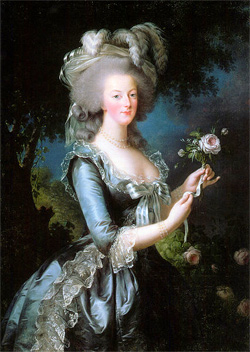Strong women rulers have always suffered violent attacks on their sexuality. To the Romans, Cleopatra was the lascivious “harlot queen,” a woman “whom her own slaves would grind.” In the Middle Ages, Isabel of England got the same treatment from her enemies, as did Catherine of Medici and Anne of Austria. Even Elizabeth I of England, the Virgin Queen who masterfully remained above the male fantasy mill, could not stem all rumors of her “uncontrollable female desires” and was thought to have been behind the riding-accident death of her longtime friend Robert Dudley’s wife.
But perhaps the most tragic victim was Marie Antoinette. From early in her rule, the Austrian-born queen inspired in her French subjects the most virulent misogyny. The market was flooded with whole libraries of violent pornography that depicted her as a wasteful and treacherous nymphomaniac who conducted orgies at Versailles, fornicated with cardinals and generals, and spied on France for the Austrians while satisfying her lusts. The most inventive, mock-serious work, Historical Essay on the Life of Marie-Antoinette hit the underground market in 1781 and was updated almost every year until her death, with vivid illustrations of the queen lifting her skirts for the entire male court. It was soon supplemented by Anandria, which depicted her in a lesbian love triangle with her ladies-in-waiting — the French having a particular obsession with the “German vice” — and sexually molesting her young son, the eight-year-old Dauphin.
This hallucinogenic strain of pornography might sound too extreme to have been taken seriously, but it resurfaced after the Revolution with concrete force as Marie-Antoinette was shuffled into ever more humiliating prisons. Her every public appearance was met with streams of abuse about her carnal desires; even a farewell to her most loyal friend, the Princess de Lamballe, who would soon end up on the guillotine, was reported in the press as a depraved lesbian embrace. The low point came at her trial in 1793, when the deposed queen — by now frail, pallid, and gray-haired — was accused before the packed court of committing incest with her son, the Dauphin. She and her aunt had supposedly slept with the boy between them and taught him to masturbate; in the pseudo-science of the day, this meant that the “Austrian harlot” had weakened the vigor and intellect of the heir to the French throne, a treasonable act to undermine la patrie.
“What mother would do such a thing?” Marie Antoinette pleaded, to no avail; she was sentenced to be “shaved by the national razor” soon afterward.
SOURCE/FURTHER READING: Schama, Simon, Citizens: A Chronicle of the French Revolution, (New York, 1990).
Footnote: Let her eat crow..
“Oh, what nonsense!” the young French queen pouts in Sophia Coppola’s film Marie Antoinette, “I would never say that!” For more than two centuries, Marie Antoinette has been reviled for supposedly declaring, when she heard the poor had run out of bread, “Let them eat cake!” — or, in French, Qu’ils mangent de la brioche, a rich, egg-based breakfast bun. But according to biographer Antonia Fraser, the charge is unfounded. The choice phrase, which became a symbol for the callous indifference of the rich, was actually used by others long before the Revolution, as recorded by the philosopher Rousseau. In fact, it was first uttered a century before by another French royal, Queen Marie-Thérèse, the Spanish-born wife of Louis XIV — and even then, she may have advised the masses to eat croûte, or the tasty crust of the pâté.
In the 1780s, the old phrase was successfully branded on the unpopular Marie-Antoinette. Ironically, as far as decadent French royals went, she was relatively compassionate. Unlike others of her ilk, she avoided riding through her peasants’ corn fields. As a teen bride, she was popular with the masses for her acts of charity, such as gifts to accident victims or dowries to “poor but virtuous working girls.” At the height of the Parisian bread riots, Marie Antoinette wrote to a friend that she felt “more obliged than ever to work hard for (the poor’s) happiness.” But this was all relative; Marie Antoinette was still a frivolous spendthrift and spent far more on gowns and jewels than she ever did on the oppressed masses, making her an easy scapegoat for France’s economic ills and earning her the soubriquet “Madame Deficit.” • 26 October 2010
SOURCES/FURTHER READING: Fraser, Antonia, Marie Antoinette: The Journey (New York, 2006).




